
These dives occurred in November 2007. It didn’t take me nine months to write all this; rather it took that long to psych myself up for the task. Don’t worry, Oksana and I resolved to buy a proper underwater camera before our next dive.Okay, where were we? Oh, yeah:
I shuffled up to the side of the boat and fixed my mask into place. Left hand securing my weight belt and dive gages, the right pressing my mask and regulator to my face. I inhaled deeply, took a giant stride forward, stepped out into space. Here comes the Great Barrier Reef.
Wait a minute, back up. Before I took the plunge into the Great Barrier Reef, I was stopped at the edge of the boat by tug on my back. One of the divemasters on board had a hold of my tank’s valve. “Who’s your dive buddy?” he asked. “Uh, my wife. Why?” “Because your air is almost all the way off,” he said while twisting the valve all the way open. “Better talk to her about that.” Oksana was already in the water; she didn’t hear the exchange. “Thanks. I’ll make sure to mention it.” We were packed pretty tightly at the rail, and the boat was rocking side-to-side in the swells. With the divemaster cranking away at my tank valve, I almost lost my balance. I took a clumsy, half-step back before I caught myself, but the underwater photographer was right behind me. The bottom edge of my tank must have bumped into the huge glass port of her camera enclosure. Behind me, I heard her say, “Shit! Shitshitshit!” When I turned to look, she was pushing her way through the crowd and rubbing the glass with her finger. I felt guilty, and tried to apologize, but she was already gone. Dive 1 – Norman Reef: Plate Top. 32min at 12m I turned to step into the water. After plunging in, I bobbed to the surface, switched to my snorkel, and put some air into my BCD. The water was surprisingly warm, only 1 or 2 degrees colder than the air, but the wind was whipping the surface into a froth. Once we dipped below the surface, however, everything was calm. The visibility underwater was disappointing. Not terrible – we could see the bottom about 30ft below us – but silty; gray. It wasn’t what we anticipated the Great Barrier Reef would look like, but then we didn’t expect a cyclone, either. We descended in pairs down to a sandy spot on the bottom and TJ took us, one at a time, through our skills tests. Take your mask off, put it back on; rest your fin tips on the bottom, attain neutral buoyancy; those sorts of things. At one point, a huge-ass wrasse swam slowly over to us. Oksana and I heard about this guy, Calvin II, at the Reef Teach. In previous years, he’d been fed by divers and grew quite accustomed to free snacks. Rather than avoid our loud, bubbly presence, he was attracted it to. TJ noticed the fish and tried to get its attention, but I was already competing for it.
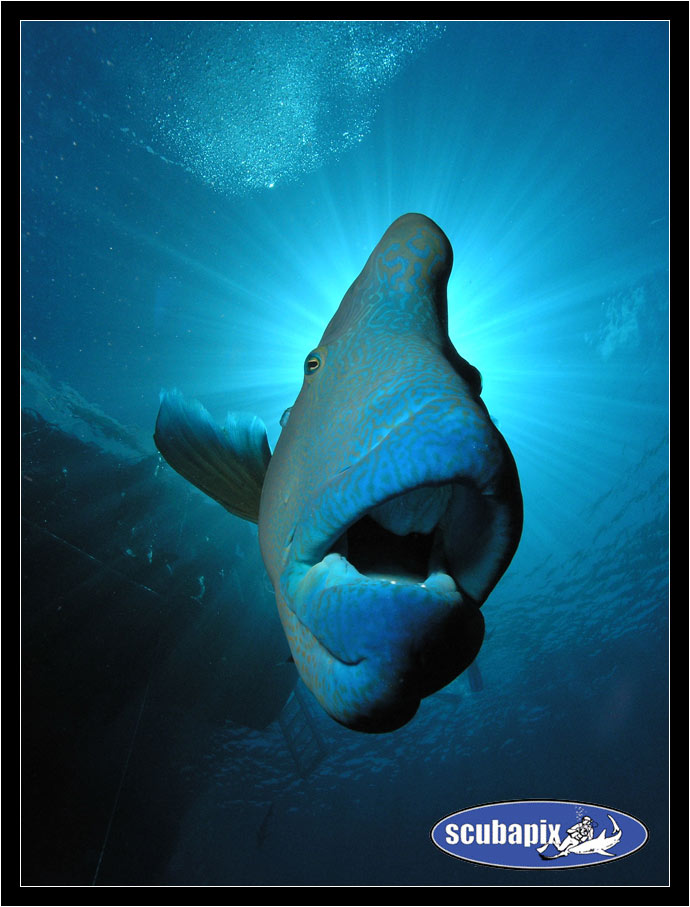
The trick, we’d learned, was to reach down and start tearing open the Velcro pockets on our BCDs. The wrasse, expecting me to produce a morsel of food, swam over. I very consciously kept my fist closed, so he couldn’t see that I didn’t have anything in it. I held my hand out in front of my chest, letting him get closer. At the last second, I opened my hand, palm up. Calvin saw immediately that I was jerking his chain, but before he was able to swim disinterestedly away, I reached up and rubbed his chin with my finger. Surprisingly soft and slimy. Sometime during the diving drills, the photographer came over and pulled Oksana and I off to the side for some pictures. We got one or two together, then individual ones next to an anemone she’s found with a couple clownfish. Just about the time we were getting back to the group, it was time for the brief reef tour TJ promised us.

Unfortunately, with all the sediment floating free in the water and most of our air being used up on class work, there wasn’t much to see. Before long, we were given the signal to surface. If anything, the weather topside was worse than when we’d gotten in 30 minutes before. Rain was coming in sideways and the waves were high enough to occasionally submerge the tips of our snorkels. Perfect weather to practice taking off our gear! First, Oksana and I traded off demonstrating the tired buddy tow. Then, individually, we had to remove our weight belts and then lift them from the water to show TJ before putting them back on. Finally, we had to take off our vest and tank, hoist ourselves up and out of the water to sit on top of them, and then finally put everything back on. The weather fought us every step of the way, but in retrospect, I’m glad we were tested in rough seas. If I ever need to remove my gear again, I’ll have the confidence to do it in just about any situation. Once we’d all passed the last test, it was time to join the line at the back of the boat. Slowly, one by one, we stripped off our fins and climbed back aboard. TJ told us to take off our gear, gather on the sun deck, and wait for him. The sun deck was only slightly less crowded than the benches with all our dive gear, mostly because all the seasick people were still up there hugging the benches, rails, and floor. I felt sorry for them. They’d come to the Great Barrier Reef from thousands of miles away, and not only were they not able to go diving or snorkeling, but their refuge, the “sun deck” was being drenched with rain. TJ came up and told us about our next dive. We were out of the water less than 15 minutes before we were suiting back up. I’d had some trouble with my mask leaking on the previous dive, so I tried putting some Vaseline on my mustache this time. Ungh, not pleasant, but it seemed to help. Dive 2 – Norman Reef: Plate Top. 23min at 12mOur second dive was rather short and, sightseeing-wise, uninteresting. We continued on with our skills assessments, taking off our masks, hovering with neutral buoyancy, all those things. A few minutes later, we climbed back into the boat. Like I said, short dive, but I wasn’t exactly disappointed.
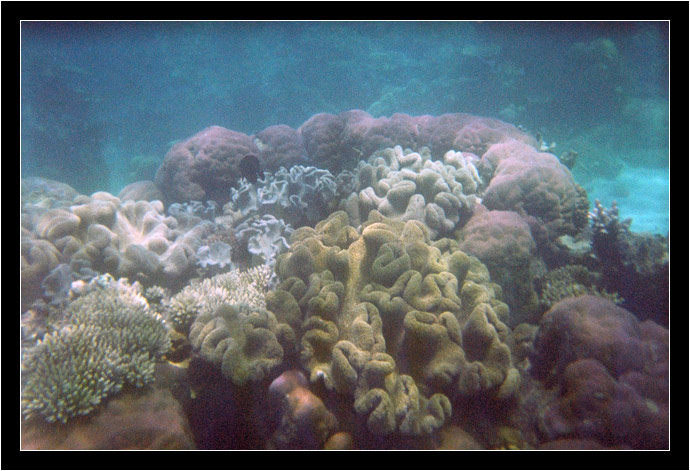
Lunch was served on the Reef Quest, and we sat around for awhile and talked about our dives. At some point, Oksana went upstairs to look over the photographer’s photos. She brought them up on her Mac laptop and when Oksana said she was interested in purchasing them, burned them off to a pre-printed CD. She even threw in a folder full of her better undersea wildlife photos and said we were more than welcome to post them on our blog. Made the $54 price tag ($13 per photo!) slightly more tolerable. Later, a larger catamaran, the Ocean Quest, pulled up alongside of us for the overnight transfers. At almost 120ft, it looked much more comfortable. Three decks, private cabins, a dining room, two sun decks, and a bar. While our luggage was handed across, we were ushered into the galley for a briefing on the ship and the daily routine. Oksana and I were given a huge room with a queen-sized bed. We had our own little bathroom, complete with shower, a writing table, tons of closet-storage space, a closed-circuit TV, and even air conditioning. Combined with three squares a day, plus an after-dinner snack, it looked like this was going to be one comfy stay!
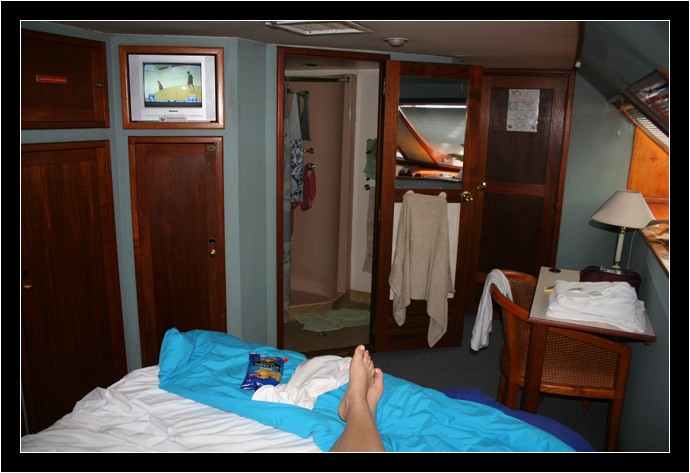
We didn’t have enough time to unpack our bags, as the first dive briefing was being called on the upper deck. We met with our group, got the low-down from TJ, and selected new gear (everything we used on the first two dives was left on the Reef Quest.) Dive 3 – Norman Reef: Playground. 55min at 12mWe spent a lot of time in the water on our third dive, but it still wasn’t sightseeing yet. The big lesson was in how to use a compass for navigation, both on the surface, and down below. Oksana and I worked well together and nailed the exercise. Here’s how it works: One person watches the compass while their buddy counts out the distance traveled in kick-strokes. Stop after a set number, use the compass to turn 180 degrees, do the same number of kicks, and you should be back where you started. It was fairly simple, but it seemed like everyone else in our group had to repeat it with TJ’s help. Which was okay with us; we used the opportunity to take a look at the reef around us. We saw a turtle swimming a ways away and a bunch of sea cucumbers in the sand around us. Once the whole group had mastered the compass, we slowly headed back to the boat and picked up a large yellow batfish along the way. He followed us right up until we climbed out of the water.
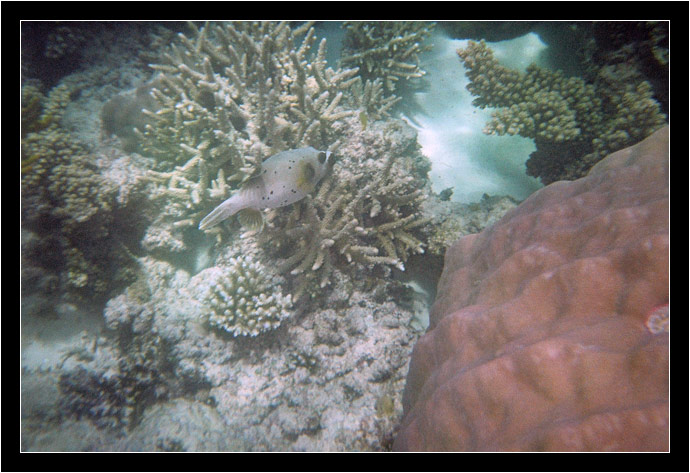
We had about an hour to kill before dinner, but most of it was taken up with TJ and the rest of the group. He showed us how to fill out our dive logs and pulled all the pertinent data from his dive computer. By the time we were done logging the three dives, it was just about time to eat. Dinner in the galley was quite good, which simply re-confirmed for us that this four-day diving excursion was a good idea. We mixed it up socially by sitting at a table with people outside our dive group. Each meal turned out to be a different cultural experience, with people from Austria, England, Japan, the U.S., or even Russia. Oksana introduced herself to two Russians that first night, Olga and Pavel. It turned out they were from… well, Denver. After dinner, there was a night dive, but we felt both too inexperienced and too tired to give it a try. We barely stayed awake long enough for the 9pm ice cream and cake dessert. Oksana fell asleep studying for some of the Advanced Open Water courses and I wasn’t far behind her. The next morning started early, with a 6am intercom announcement for the first dive briefing. This was our first full day on the Ocean Quest and the schedule looked something like this: 6:30am Early dive 8:00am Breakfast 9:00am Morning dive 11:00am Late morning dive 12 noon Lunch 4:00pm Afternoon dive 6:00pm Dinner 8:00pm Night Dive 9:00pm Dessert It may seem like there’s some down time in there, but let me assure you, there’s not. If you’re set on doing all five dives, it’s going to be an exhausting day. This day started with ibuprofen and aspirin. I was sore from the previous day’s dives. We slept through the early morning dive, but managed to drag ourselves out of bed for breakfast. Our final Open Water qualifying dive was scheduled for 9am. While the normal dive briefing was going on, TJ took our group aside and told us what we were going to do. Being the first dive of the day, we would be going deeper than normal because all subsequent dives should always be shallower than the last. Dive 4 – Norman Reef: Tropos. 30min at 18m Our first exercise was a practice run of an out-of-air emergency situation. The eight of us descended a line hanging down from the stern of the boat and waited there while, in buddy groups of two, TJ pulled us aside and watched us go through the Controlled Emergency Swimming Ascent routine (get buddy’s attention, signal you’re out of air, borrow their alternate regulator, lock arms, slowly ascend). There wasn’t much room to hang onto that single line and, while we waited for our turn, my regulator hose managed to get snagged on another diver’s tank valve. I didn’t realize what was happening at first, only that something was threatening to pull my air supply from my mouth. I was able to turn my head far enough to see what was going on, but when I tried to pull the hose free, I couldn’t reach the other person’s tank. I tried a couple of head jerks to free it, but to no avail. The other diver, feeling her tank snagged on something she couldn’t see, started to twist and turn. At this point, the only thing keeping the regulator in my mouth was my tightly clenched teeth. Oksana saw what was going on and began to push past me and get the other diver’s attention. It’s hard to describe what was going through my head at the time. I was worried, sure, because my regulator was almost being ripped from my mouth, but I wasn’t exactly scared; we were only about 12 feet down. I kept thinking, there should be something I can do to get out of this situation without help, but for the life of me, I couldn’t think of what. As Oksana, eyes wide with sympathetic fear, reached past me, it hit me like a big wave of duh. I held up a finger in front of her mask: wait. I took a deep breath, removed the regulator from my mouth, and exhaled a slow stream of bubbles through my lips. The hose was still tucked under the other diver’s valve, but with the extra reach my arm offered, I was able to turn to face her and lift it clear. I tucked it back between my lips far before my lungs were out of air and signaled “okay” to Oksana. It was another one of those moments where I realized how well we’d been trained. After we’d all passed the CESA test, TJ took us on a tour of the reef. The weather had miraculously cleared – Guba must have finally moved off or spun itself out – and the clarity of the water was much improved. We slowly swam along some coral formations as TJ pointed things out. Shrimp, parrotfish, corals of every type – there was something to see around every bend. At one point, our instructor swam down and picked up a sea cucumber. The cuc decided it was in trouble and puked its guts out – long, stringy, white strands that drifted in the current. He (TJ, not the cucumber) motioned for us to touch the ropy threads. I knew what he was getting at – we have sea cucumbers in Alaska – but no one else was taking the bait, so I reached out with a finger and brushed one. That was enough for some of the others in the group to reach out and grab some of the other strands, too. You want to talk sticky, let’s talk sticky. Those sea cucumber entrails were amazing. The tiny section that brushed the pad of my index finger would not come off. I dragged my finger through the sand, I repeatedly rubbed it back and forth along the neoprene of my wetsuit – to the point where my finger heated up from the friction – and when I got back to the boat, there were still tiny fragments clinging to my finger. I mentioned to TJ how impressed it was; he laughed and said if I thought that was impressive, I should see what happens when you put it in someone’s hair! As we climbed out of our gear and toweled off, Sylvia remarked to the group, “Okay, I get it now. After yesterday’s dives, I kept wondering what all my diver friends kept raving about. But today,” she gestured at the blue sky and sun, “the clarity of the water, the colors down there, everything we saw. I get it now!” The rest of us tended to agree.

Almost as soon as we got out of the water, it was time for the 11am dive. TJ turned us loose for our first “fun” dive. Oksana and I went upstairs for the dive briefing and carefully planned how we’d do our first unsupervised dive. The dive briefings on board the Ocean Quest were quiet thorough. Before each scheduled dive, a divemaster would use an elaborate whiteboard drawing to point out the underwater formations, what we were likely to see, where the boat was anchored, and what the current conditions were like. We were still at Tropos, the same as the 9am dive, so we decided to focus on sightseeing while trying to pay attention our location in relation to the boat. Dive 5 – Norman Reef: Tropos. 27min at 14mOnce we got in the water, Oksana and I made sure to talk through our plan again on the surface. We were going to descend down the stern anchor line, get to our planned depth, then swim up-current into the shallows. When our air started to get low, we’d head back to the boat, practice a safety stop at 5 meters, then get out. In agreement, we popped our respirators in and went under. Surprisingly, to us at least, we executed our plan to perfection. We didn’t see a whole lot that we hadn’t already seen on other dives – a clownfish here, a parrotfish there, a tiny school of fish darting among the spires of some staghorn coral – but we did just what we wanted to. Went deep, explored the shallows, had fun.
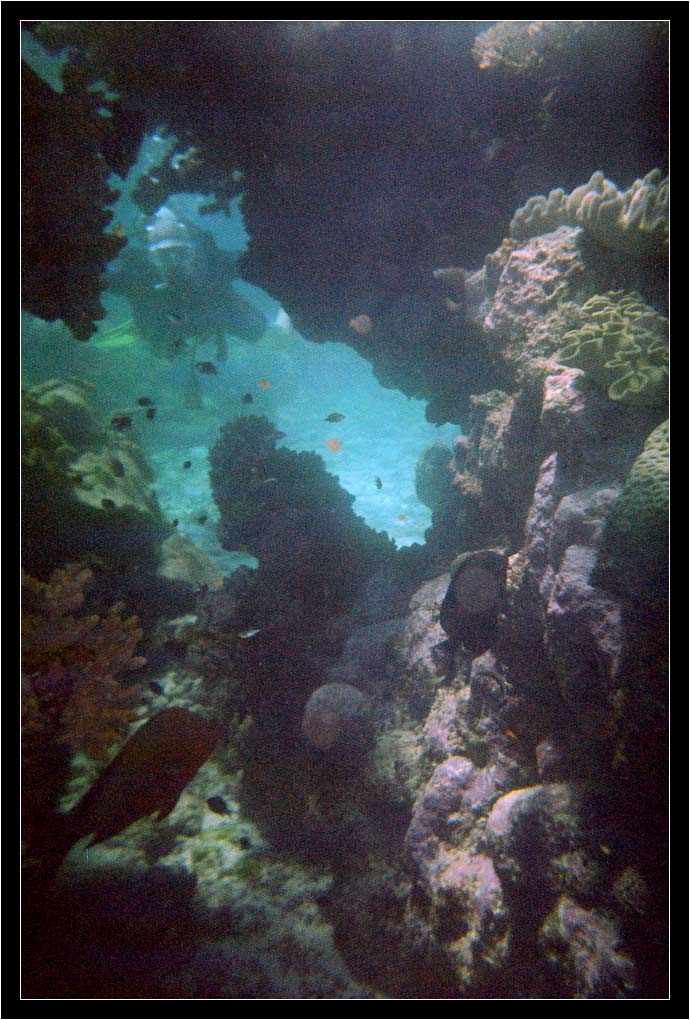
Oksana, caught up in the exploration of the reef, lost track of where the boat was, but I was able to lead us right to it. Other than the dive going too quickly – I was always the one breathing my air too fast – it was a great, first “solo” dive. Once we’d toweled off, we met with our group in the cafeteria for more paperwork. This time, there were extra forms to fill out, both for us and for TJ. When we were done, he pushed our temporary dive cards across the table. “Congratulations,” he said, “you’re now officially Open Water certified!” It would have been nice to toast the achievement with the group, but there was more diving to do, and while the bar would have served us a drink, it would also have taken away our dive privileges for the rest of the day. While the others in our class were free to kill time before the 4pm dive however they liked, we had to study for the first of our Advanced courses. So while they sat up on the sun deck, we… sat up on the sun deck with books. Our next dive was to be the peak performance buoyancy test. TJ pulled in a couple new arrivals that were also taking the advanced course. They were both from the UK, I think, but not together. TJ gave us all the rundown and then took us down. Dive 6 – Norman Reef: Playground. 28min at 15mRunning through the peak performance buoyancy test was sort of fun, actually. We started out on the bottom, in a sandy section, spread in a semi-circle in front of TJ. He had us demonstrate the fin pivot and hover first. While we followed his directions, a huge batfish swam into the class and checked each of us out. When TJ wiggled his finger near him, the fish took a nibble and almost broke the skin.
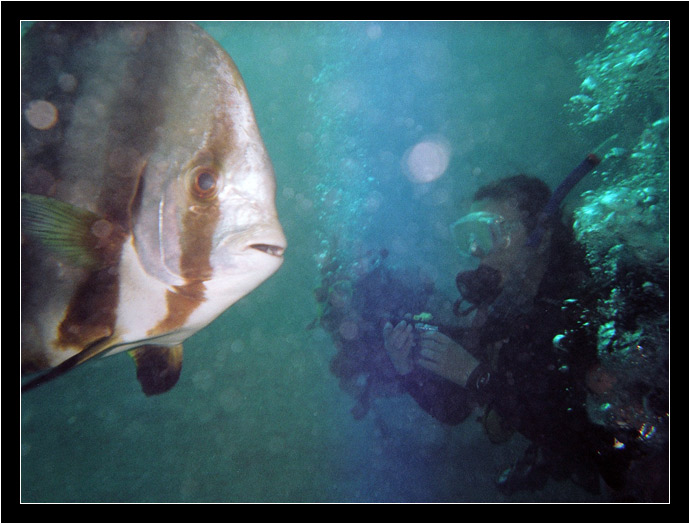
After we proved our ability to do the simple stuff, TJ set up the hoola-hoop he’d been swimming with. A weight belt was tied to the hoop with a string so that, when he let it go, the bottom edge floated about 2 feet off the bottom. In turn, we had swim – slowly – toward and through the hoola-hoop, using the air in our lungs to keep us perfectly centered within the circle. With the tank on our back and kicking legs, there wasn’t much room for error. If we touched the edges, we had to swim back and do it again. Then, to make things just a bit harder, he added a twist. He positioned himself about five feet in front of it. On our second pass, he handed us a small weight belt. You really had to time your breathing to prevent it from dragging you down into the lower edge of the hoop. The exercises took long enough that we didn’t have any time left for sightseeing. Nevertheless, our batfish friend entertained us all the way back to the boat. Our next dive wasn’t until 7:30pm, but with dinner in between, we didn’t get a chance to study for it. This was to be our first dive with a new instructor, Lani, a Korean girl with a thick (but endearing) accent and a perpetual smile. Even before getting suited up, it sounded like it was going to be an exciting dive. As the sun set, people gathered on the rear sun deck to watch all the fish gathering in the boat’s lights. Every once in awhile, a huge shape would swim into the school, scattering them under the boat. Reef sharks. The dive briefing was delivered by an entertaining and hilarious (if I placed the accent correctly) Scotsman. “If you’re shining your torch around down there in the dark and you happen to see a green dot, don’t worry. That’s just a shark’s eye reflecting the light. If you only see one, no problem; that means he’s swimming by you. But…” he paused dramatically, “if you see two green eyes swimming towards you, well, you better hope you’ve stumbled upon two one-eyed sharks swimming together!” He also told us about the giant travelli, a fish that has grown so accustomed to divers on the reef that it uses their flashlights to hunt at night. As divers shine their lights around, looking for interesting (perhaps sleeping) fish, the giant travelli will dart into the light and snatch it up. “You will have great power down there; the power to wipe out the entire reef. Be kind. I try to limit myself to only one sacrificial fish per dive!” Dive 7 – Norman Reef: Playground. 29min at 11m Lani took us down into the water and, before we could go off and enjoy ourselves on the reef, we had to pass another navigation test. We descended half way down the anchor line and waited for her. One by one, she followed each of us as we used our wrist compasses to swim out into the dark for 10 kicks, spin around, and kick back. Even with our previous navigation training, it wasn’t easy in the dark. It was easy to swim in a straight line, but without anything for your peripheral vision to lock on to, it was difficult to stay at the same depth. I started to rise towards the surface; Lani told me after the dive to work on keeping my head level. It’d tilted it up and my swimming simply took me in that direction. Other than that, Oksana and I did just fine. Unfortunately, the other guy in our class didn’t do nearly so well. While the British girl, Oksana, and I hung on the line, Lani went off with him on his test. They disappeared. They were gone so long (more than 5 minutes, maybe as much as 10) that I seriously wondered what we were supposed to do. Surface? Wait on the line until our air got low? Descend and explore? The three of us alternated shrugging at each other and peering into the dark. It wasn’t necessarily time poorly spent. From our vantage point in the dark we could see the huge floodlight shining down from the bow of the boat and the hundreds of fish teaming within the light. Plenty of sleek shark shapes moved in and out of them and every once in awhile we’d see those eerie green eyes passing near us. Despite all the talk of there never being a shark attack, it still gets the heart pumping to see (or rather NOT see) those sharks swimming out of the dark. Eventually (finally!) they returned from the surface where, apparently, Lani had eventually taken him because she just could not get him to understand A) the rules for the test, nor B) the simple hand signals to explain such. He tried to laugh it off later, but we trusted his reaction less than Lani’s obvious exasperation. When they returned, Lani took us down the line to the bottom. She showed us around the reef in the dark, the cones of light coming from our flashlights were the only illumination. Some animals were easy to spot – tiny pink spots reflecting back turned out to be shrimp eyes, and we could spot the movement of the occasional fish hiding among the coral. At one point, a huge shape passed swiftly by my arm. I had no idea what it was, but it was big enough to give me a scare. Before I could swing my light around to the blackness behind me, it was gone. I went back to looking at the reef, shining my flashlight into the cracks and crevices. All of a sudden, a tuna-sized monster of a fish torpedoed between my right arm and body, snatched a small fish out of the light, and disappeared. Ladies and gentlemen: The giant travelli. It must have been hovering behind my shoulder the whole dive. Yeesh! After four dives, we wanting nothing more than our bed, but Lani wanted us to gather in the galley for a study session. Basically, she had us run through the appropriate chapters in our PADI textbooks for the advanced skills we were learning (Peak Performance Buoyancy, Night Dive, Deep Dive, etc.) Rather than waste time reading it ourselves, she simply ushered us through the 10 question quizzes at the end. We took turns reading each question and guessing at the answers. Not hard to get 10 out of 10 on a quiz when all the answers are supplied. Oksana and I were determined to take advantage of all five dives the next day, so that meant getting up at 5:45am. The study session pushed back our bedtime until 11pm; it was a short night. Dive 8 – Norman Reef: Playground. 28min at 23.5m The first dive of the morning was our Deep Dive. We were suited up by 6:30am and in the water not long after. Lani was our instructor again, and our classmates were the same two Brits and a new German guy. We descended down the stern anchor line to 23.5 meters, about 77 feet, the deepest we’d go on the Great Barrier Reef. In the cracks between the large mooring blocks of concrete on the bottom, I spotted three lionfish with their fanlike fins spread out. Lani led us over to an open sandy area and commenced her teaching. First, she showed each of us, in turn, her dive computer. She was emphasizing how quickly our air went at this depth; we had only 14 minutes of bottom time remaining. Next, she demonstrated how much color was filtered out by the water above our heads. Reds are the first to go, so she pulled out a tomato. Not only was it muddy brown instead of red, but it had been squished down to the size of a cherry tomato by the pressure. We were passing it back and forth to get a closer look when a sea bass darted into our circle and swallowed it whole. Next, she pulled out a raw egg and tapped it with her dive knife. The shell collapsed as soon as the surface was cracked and when she stripped it away, the yolk remained whole. Again, it didn’t appear to be the yellow of a normal egg yolk, more of a dirty mustard. The egg white didn’t hold together, it fell away in wispy strands of mucous. Before she could pass it along, the same sea bass swooped in for seconds. She cracked another one and tried to shield it from our hungry friend. That second egg was passed around until it got to me. Mr. Sea Bass became so impatient, he finally decided to push right through my hands, physically brushing me with his scales. Hungry fish. The last task, which we barely had time for, was a sort of nitrogen narcosis awareness test. At depth, the nitrogen accumulation in your bloodstream can begin to have an impairing, sort of intoxicating effect on a diver. Like altitude sickness, there’s no real way to gage when or how much a person will succumb to it. Unlike altitude sickness, a diver often isn’t even aware it’s happening. To demonstrate, she brought down a small whiteboard. It was divided by lines into a grid. Into the boxes of the grid, Lani had written the numbers 1 through 25 in a random order. We were supposed to tap out the numbers, in order, with our index finger while she timed us. Later, back on the sun deck, we’d do it again and compare times. I got the exact same time, both times; 30-some seconds. Oksana went from 60 seconds underwater to 40 seconds topside, but it wasn’t nitrogen narcosis that was the problem. When she paused at one point, seeking a certain number, the British girl in our group reached in and pointed it out. I mean, what the hell? Oksana was so startled (and annoyed), she turned to glare and that cost her a few more seconds. You know, come to think of it, maybe nitrogen narcosis was the problem… just not for Oksana. On the way back to the surface, we made sure to take our safety stop at five meters. Because our air was expected to be lower than normal after the deep dive, there was a full tank of air suspended on a line in the water, just in case. We didn’t need it for our three minute wait, but it was close. I got out of the water with my tank just barely dipping into the red: 50 bar. Later, as we regrouped on deck to go through the finger-tapping exercise again, Oksana was concerned enough about British girl’s behavior underwater to ask her if she was feeling okay. Her answer was strangely curt: “Yes.” No further clarification, not even any bewilderment at the question. We vowed to avoid her as much as possible from then on. We ate breakfast with our previous classmates, Christian and Giselle, and told them how the advanced course was going. Afterwards, we managed a 25-minute catnap while the Ocean Quest moved to a new reef. Dive 9 – Saxon Reef: Twin Peaks. 29min at 17m We were back with TJ again for the next dive, the Advanced Underwater Navigation course. This turned out to be another dive compass test and Oksana and I aced it. The first lesson was to get an awareness of the distance our kick-strokes would take us. We used the length of the ship as a benchmark, counting the number of kicks it took to get from the stern to the bow. Twenty-five for me, thirty-five for Oksana. Once on the bottom, we paired off to practice navigating through a square pattern. Much like the earlier (but easier) compass tests, we started out swimming along one compass bearing. Instead of turning 180 degrees and going back, however, we turned 90 degrees and continued the same distance. Two such turns later, we were right back where we started. We had enough time for a short trip along the reef, with TJ taking us through some intentional twists and turns. As our air began to get low, he turned to a couple students, shrugged his shoulders and then cupped his hands: Where’s the boat? I was disappointed that he didn’t ask me, because I was sure I knew which direction was correct. Our 11am dive was with Lani again. To finish the advanced course, we had to complete a total of five “adventure dives.” This was our fifth. I badly wanted to do Underwater Photography or Videography, but Lani kept pushing us towards the AWARE – Fish Identification Dive. Although never said outright, I could tell the reason was because the fish ID course was a stupidly easy course to teach. Basically we went for a dive, saw some fish, and pointed them out on a chart when we were done. This was the first (and luckily the only) bullshit dive in our PADI coursework. Dive 10 – Saxon Reef: Twin Peaks. 33min at 17mNevertheless, the dive started with a cheap thrill. Since there was a huge line of people waiting to get in the water, Lani opened up the rail and let us giant stride in from the second deck. Oksana was nervous about dropping in from six feet up, but she did just fine.

We followed Lani around the reef as she pointed out certain fish. The pace was leisurely, not at all like the skills assessments we ran through on the other dives. Oksana and I were enjoying ourselves. Unfortunately, both the Brits were with us again and this time they had cameras. Completely oblivious to their surroundings, they viewed their entire dive through tiny LCD screens. More than once, one or the other of them swam directly into us. At one point, I had my mask kicked loose. Irritated, Oksana and I fell back and made sure to keep our distance. Comically, their faces were so glued to their viewfinders, they both began following the wrong group of divers. At one point, Lani looked around, signaling to us “Where’d they go?” We all did a slow 360, but couldn’t see them anywhere. She signaled for us to stay put and swam off to retrieve them. This would have easily been our most disappointing dive of the trip, if not for some of the wildlife we spotted on the reef. Our first shark in daylight, a baby. Clownfish in anemone. A squid-like cuttlefish hovering in the water. Lots of awesome. Towards the end of the dive, Lani asked everyone how much air they had left. We were all surprised to find that Mr. Brit was already in the red zone at 50 bar (especially since there was a standing rule to let her know when we reached 80 bar). Even though the rest of us still had plenty of air, Lani directed us, hurriedly, back to the boat. After our three minute safety stop, he was down to just 30 bar. Lani was not pleased. I couldn’t catch what was being said on the surface, but she had words for both of them. Oksana had one more run-in with the Brit girl while climbing up the ladder onto the deck. Oksana had waited in line to get out of the water, like everyone else. On her turn, she grabbed one handle of the ladder and started taking off her fins. She had her right hand on the rail and her right foot on the bottom rung, when Ms. UK shouldered her aside and climbed up past her. Oksana – one of her fins already on the deck – let her irritation show through, saying, “Excuseme?” but Ms. Brit didn’t even look back. Thank God our Advanced Open Water course was officially finished. We had nothing but solo dives to look forward to. Lunch time. Three dives down, two to go. We ate with Chris and Giselle again and I got my laptop out to download a few of their digital photos before they left. We took a few minutes to pack our bags and switch from a queen cabin to a twin; two beds instead of one, but with a better view. We met with Lani to finish up the paperwork for our advanced certification, then spent the remaining time before the Reef Quest arrived hanging out in the bar with our Argentinean friends. Sadly, they disembarked for the ride back to shore shortly afterward.

At 3:30pm, we went up for the next dive briefing. This was a new site and we were going without a guide; we paid particular attention to the details. Oksana and I took a few extra minutes to discuss what we wanted to accomplish. Our biggest goal was to maintain an awareness of where the boat was. We wanted to make absolutely sure we weren’t going to be one of those divers that they have to retrieve with the Zodiac. For my part, I wanted to take lots of pictures with the disposable underwater camera we’d purchased back at the dive shop.
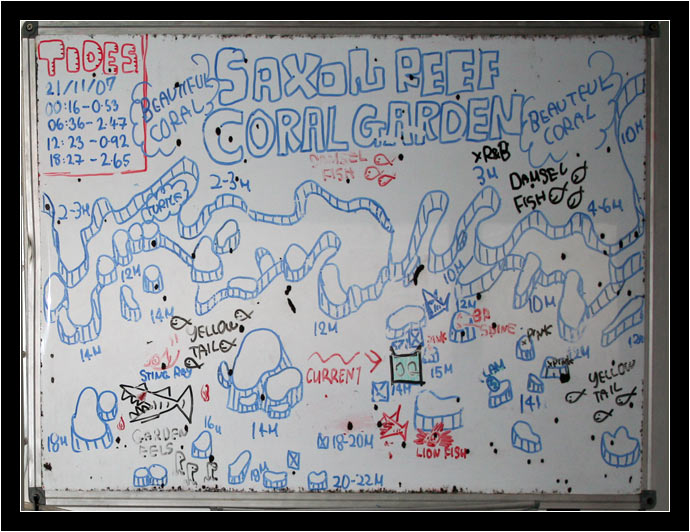
Dive 11 – Saxon Reef: Coral Gardens. 31min at 15m The dive was a success, even if we didn’t see a bunch of new stuff. We descended down the fore mooring line this time, then set out in a line from the port side of the boat. There were plenty of ordinary fish to see, parrotfish and the like. At one point we came across a large swath of storm-damaged coral. The highlight, by far, was coming across a turtle. Completely unperturbed by our presence, we swam right up to him and snapped pictures from less than a foot away. Just to see what it felt like, I placed the lightest touch of my index finger on his shell: slimy and rough, like algae growing on sandpaper. We never strayed too far from the boat, so finding it again wasn’t a problem. I felt confident that I knew exactly where the boat was, but asked Oksana for her opinion, anyway. She signaled in a different direction, but with a shrug. We were going to need some more work on that. When we got out of the water, the divemaster standing at the rail had us sign back in. For the first time, she asked for our depth and time. I wondered if she was just checking up on us because this was one of our first solo dives, but it turned out to be a routine question. Flagging after four dives, we weren’t sure we’d to make it to the night dive. We went to our new room and while I worked on my dive log, Oksana took a brief, deep nap. We left the room again for dinner, where we sat at a table full of Japanese tourists. We were fascinated by their vacation schedule – some of them had literally only 3 or 4 days off. They would spend a full day traveling to Australia, spend one day diving on the Great Barrier Reef, then spend the next day flying home. The diving was great, I won’t argue that, but I don’t know if it was that great! While we listened to the dive briefing for our night dive, I hung back by the stern rail. Looking down into the water, I could tell there were a lot fewer fish than the night before (and no sharks at all.) My disappointment foreshadowed the dive. Dive 12 – Saxon Reef: Coral Gardens. 31min at 14mOksana and I opted for the brighter flashlights this time, paying a little bit more for the rental privilege. We worried at first about finding our way back to the ship, but we quickly realized that the incredibly bright bow light could be seen from any reasonable distance. Once underwater, we concentrated on finding cool stuff. Again, we saw a couple giant travelli, but they only ever circled the outside edges of our light; they never attacked anything. Instead, we happened across what may have been a wobbygong, patiently sitting on the bottom of the ocean. While we watched, an unfortunate little fish swam in front of its flat, ugly head and, after a split-second sucking motion from the wobby, disappeared. Twenty-five minutes into the dive, we’d only seen a few more pink shrimp eyes and a couple giant clams, but at least, for once, the air in our tanks outlasted our allowed dive time!
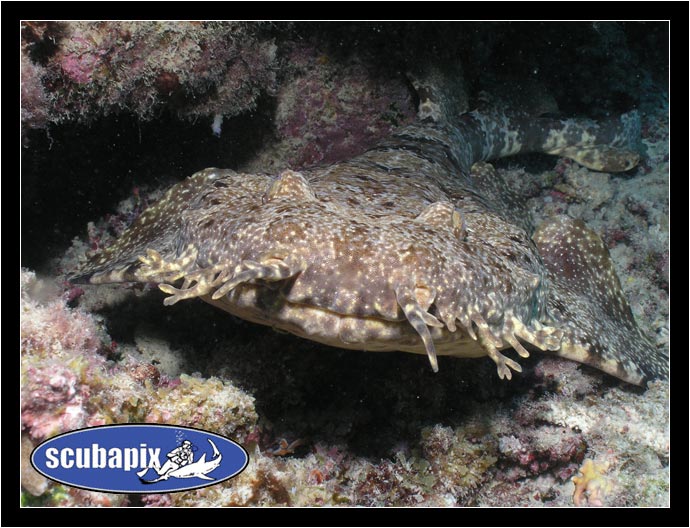
In checking our dive computers, we realized that we’d somehow gone about two meters deeper than we should have. Combined with the time we’d accidentally surfaced in the shallows, it left us thinking that we weren’t diving quite as well as we thought. We grumbled a bit at each other, not quite placing blame. I think we were simply tired after a long, long day. Wednesday, our last day aboard the Ocean Quest, started at 5:45am again. We rolled out of bed, climbed into our cold, wet swimsuits, and shuffled up to the 6am dive briefing. We were dead on our feet, but determined to get the most out of our last three dives. Dive 13 – Saxon Reef: Coral Gardens. 29min at 20.4m Our first dive had to be the deepest, so we descended down the anchor line to about 20 meters. While I fiddled with my buoyancy on the sandy bottom, Oksana started motioning wildly for the camera. As I handed it over to her, I looked around, but didn’t see anything. Apparently, another curious sea bass had taken a keen interest in the silver cap on my snorkel. He hovered near my head, usually just outside of my peripheral vision, for the next five minutes. We swam off, against the current, to the starboard side of the boat. Before long, Oksana spotted the first great find – a sleeping shark! We’d been told that, this early in the morning, many fish might still be asleep. There, right in front of us, was a small shark, maybe two feet long, resting on the sand. We swam closer – how could we not? – but eventually it noticed us and swam away. About ten feet away, then it went back to sleep. We continued along the reef, watching parrotfish eat, seeing whole schools of fish wake up. As my air dipped down under 80 bar (my air was always our limitation, Oksana always had more), I signaled to Oksana that it was time to head back. Moving now with the current, I took my best guess on the line back to the boat. Visibility wasn’t great; we weren’t even able to see the hull when we were 20 meters right below it. I hoped we were going in the right direction. We rose up off the bottom as we swam so that we would hopefully be in sight of the boat when we reached our safety stop height. It was a good thing we were rising as we went, as we apparently crossed into the nesting area of a triggerfish. As we looked down at the sandy bottom, barely visible below, we noticed a fish, maybe two feet long, rising up to meet us. Just about the time it decided we weren’t a threat and turned around, I noticed the sharp, bucked teeth jutting from its face. The divemasters warned us about these guys. One said, “Sharks? I don’t mind sharks. In fact, I not afraid of much anything in the ocean… except triggerfish. I hate triggerfish. Mean little bastards!” Right about the time we hit our safety stop depth, we saw the mooring line cutting through the water. My navigation was spot on; we were exactly where we wanted to be! Dive 14 – Saxon Reef: Clipper. 28min at 18.5mThe next dive, at 9am, was one of the most memorable of the entire trip. First, we stepped in from the second deck again, because the line was so long. Oksana lost her mask when she hit the water, but she managed to find it again before it sank. We made a mistake in descending the aft line. The current was very strong and we wasted air fighting our way into the shallows. However, we did see another beautiful lionfish between some rocks, and spotted a ray flapping his way along the sandy bottom. I tried to follow it to get a picture, but Oksana pulled me back when she realized I was heading toward deeper water. Just before we reached the reef in the shallows, I noticed something strange on the bottom – a cinderblock. Right there, in the middle of the Great Barrier Reef, 60km off the shore of Australia… a cinderblock. I figure it must have been used as some sort of weight or anchor, but still, strange to see. Once in the shallows, we stumbled across the most spectacular sight: two cuttlefish, hovering in place over a rounded coral formation. They were alien in appearance, with their strangely hooded eyes and short tentacles. They hardly seemed to move at all, despite the slight surge caused by nearby waves. I held the camera out in front of me and slowly swam forward. I got right up next to them, too. There was a thin, translucent frill running around the perimeter of their bodies. After I stopped focusing on my camera’s buttons, I took a closer look. Blue bioluminescent dots blinked on and off in a pattern along the frill like a string of Christmas lights. As I got closer, they turned white. I could have watched them all day, but another group of divers was coming closer and I backed off to give them some space. Even before I got out of the water, I couldn’t wait to have the pictures developed.
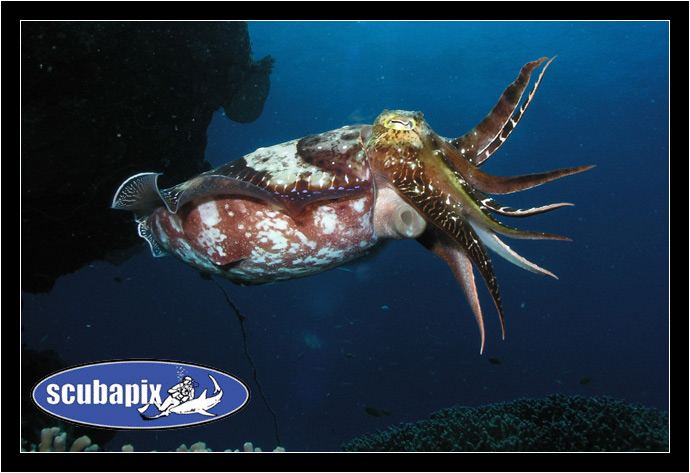
On the way back to the boat, a triggerfish once again moved menacingly close to us on our safety stop. He (or she?) came up off the bottom a couple times, big chompers leading the way. Oksana and I knew what we were looking at this time, however, and we kept our fins pointed down. Take a chunk out of those, not my fingers! Fortunately, we must have been a little too far from the nest, because it never quite rose all the way to meet us. We had only enough time to dry off and work on our dive logs before we were back in the water for our 11am dive. Dive 15 – Saxon Reef: Clipper. 33min at 13mSince we wasted air fighting against the current on our last dive, Oksana and I decided to start out with a surface swim toward the shallows this time. It was our last dive on the Great Barrier Reef and we hoped to preserve our air supply by spending most of our time above 10m. The sun was shining strong, the water clear, and colors vibrant. We wove in and out of the coral formations, zigzagging whenever something interesting caught our eye. Oksana found a huge ball of fish, but they scattered before she could get close enough to take a picture. I found another anemone with clownfish and managed to pose Oksana right up next to it for a photo. The shallows were full of fish, giant clams, and corals of all types. We realized that spending most of our previous dives in deeper water had been a mistake.
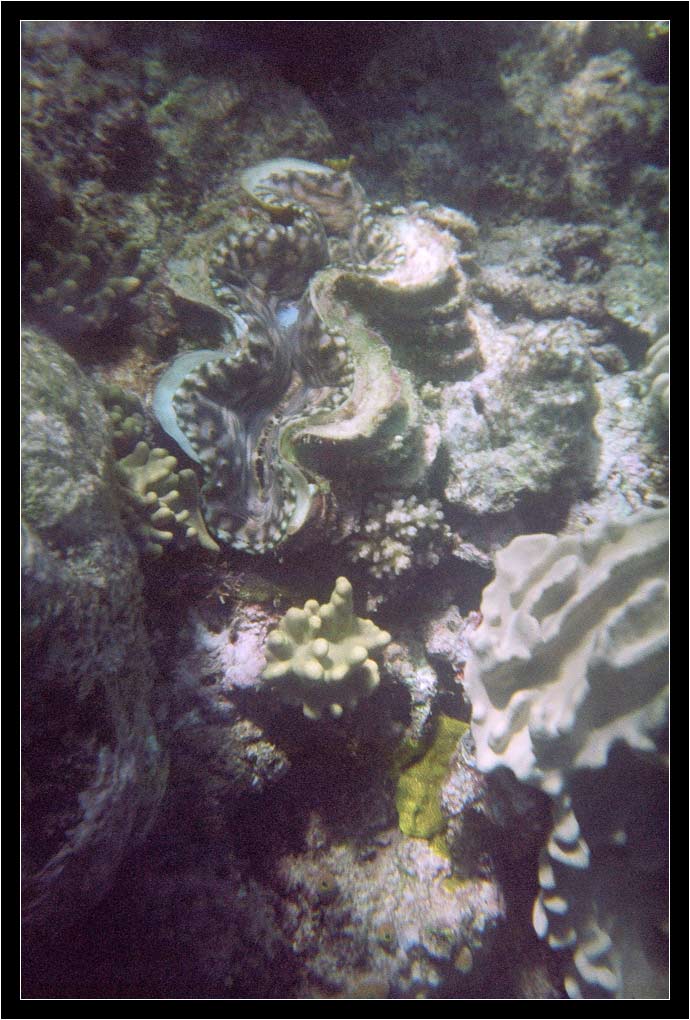
At one point, I found myself swimming between two large coral formations. The sandy bottom below me disappeared underneath a shelf. Consciously aware that I wasn’t yet the kind of diver who sticks his hand into holes or swims into tight crevices, I decided to take a look anyway. I tipped myself forward and swam head down. As soon as my upper body cleared the coral ledge I saw the beady eyes of a shark staring back at me. Oksana was the one with the camera and she was off in the distance checking something else out. I filled my lungs with air and gently rose above the ledge before kicking my way over to her. Once I had her attention, I communicated via a series of hand gestures. Hand over my head, fingers together and pointing straight up: SharkPointing back towards the shelf: Over therePointing back at Oksana: YouMaking a fist, then stuck out the index and middle finger and wiggled them: SwimDrawing a line in the water with my index finger, gesturing around the coral wall: Around that coral formationI made a rectangle with my index fingers and thumbs, moving the right index finger up and down: Take a pictureShe nodded; we were getting better at communicating underwater. Oksana approached the coral formation the same way I did, from above, so the shark wouldn’t see her coming. I watched her from behind as she readied the camera. Controlling her descent with the air in her lungs, she drifted slowly down until she could see its sleek body on the sand. I could tell when she switched her attention from her buoyancy to the camera. She stopped kicking her fins to get a steady shot and continued drifting down towards a large, bushy formation of staghorn coral. I wanted to warn her, but I was too far away to use touch and I had no way to make a sound loud enough to get her attention. The next part happened in slow motion – and not just in my mind – the motion really was slow! Oksana’s fins were the first point of contact with the coral. Her attention was still focused on composing her picture, however, so she just bent her knee a little bit to maybe kick a little and rise up. Unfortunately, her knee bashed into the coral, too. At that point, she did what most divers would do when making contact with something she didn’t want to damage, she point out her hands. And, of course, one of them scraped across the rough coral, too, and scratched her palm. I could almost read her mind, probably because I was thinking the same thing. Hand. Cut. Blood in the water. Shark.She dropped the camera; it dangled from the attached wrist strap. Without even looking back in my direction, she started swimming away with long, hard kicks of her legs. I moved after her, sparing a glance at the shark as I passed its sleeping spot. Oksana finally stopped to look at her hand. I swam up to her and took a hold of her wrist so I could see for myself. Nothing – no blood anyway – but a few small, white scratches. I lifted my gaze to her eyes, a questioning look on my face. Her eyes were huge, but she just smiled around her regulator, put the heel of her hand against her chest, and slapped her fingers over her heart a few times.
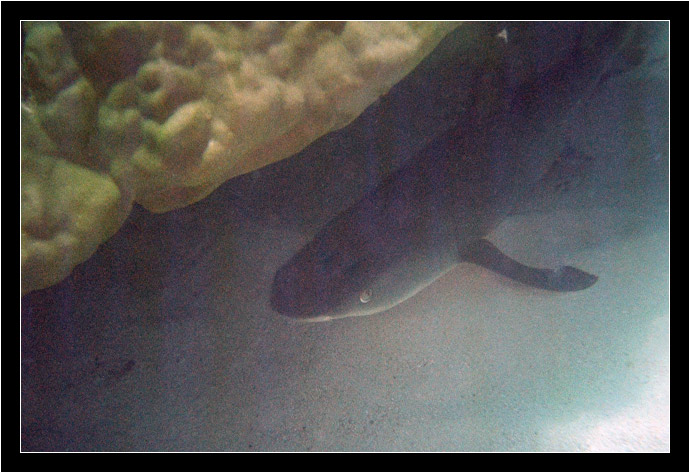
I motioned for the camera and told her to stay where she was, a safe distance away from the shark. I went back to get the photo myself. Again, I approached the shelf from the top down, and took a picture as soon as the camera cleared the edge. The shark, annoyed now at all the activity around it, decided to swim away. Of course, as it left the shelter of the ledge, it swam right for Oksana. I watched her freeze up as it passed directly beneath her in the water. We had a good laugh about the whole encounter later. We still had plenty of air, but thought we should start heading back towards the boat. I asked Oksana where she thought it was and agreed with the direction she indicated. We started swimming that way, still enjoying the view of all the life among the coral. After a few minutes, we still hadn’t seen the hull above us, but that wasn’t too out of the ordinary. The visibility wasn’t great. We decided we were close enough to surface. Boy, were we ever wrong! We must have really gotten turned around in all those winding coral paths, or maybe we were carried off course by the current, I don’t know, but The Ocean Quest was at least 200 meters up current. A tiny figure on the top deck noticed us and I used my arms to make a big circle over my head: I’m okay! Embarrassed, but okay. We switched to our snorkels and checked our air. I still had 70 bar left, not yet into the red. We could have submerged again and started swimming back to the boat, but we decided to just inflate our BCDs and kick along the surface. Self-inflicted punishment for navigating so poorly. The divemaster on top of the Ocean Quest was still watching us. He signaled again, making a big “O” with his arms. I imagined he was asking, “Are you sure you don’t want me to send the Zodiac?” Both Oksana and I sent back “O’s” of our own and started fighting back against the current. We climbed out of the water with tired legs, but otherwise no worse for wear.
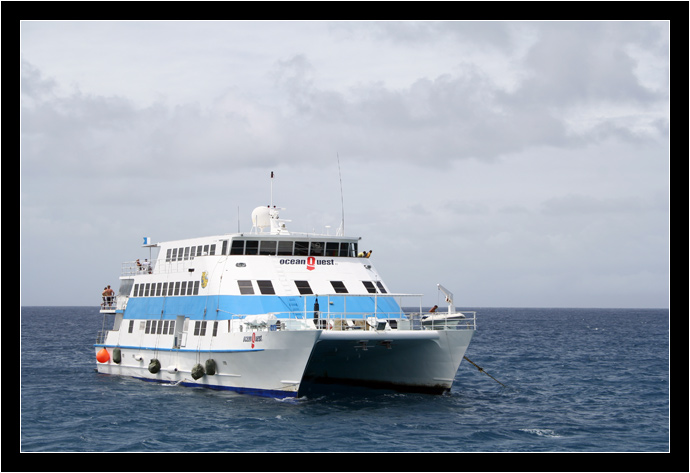
The Reef Quest wasn’t coming to pick us up until later in the afternoon, so we had plenty of time to unwind after our last dive. We took showers and dressed, ate lunch, and climbed to the upper deck for the first time. While Oksana caught some shuteye, I took some pictures of the reef and watched the other boats (and helicopters!) full of snorkelers empty their contents into the water. We transferred onto the Reef Quest at 2:30pm and settled in for the ride back to Cairns. By 4:30pm we were back at the dive shop, and shortly afterwards we were checking into our hotel again with all our bags. We were sad that the diving portion of our trip was over, but not necessarily disappointed to leave the hectic schedule behind. We awoke the next morning to the realization that it was Thanksgiving in the United States. Rather than spend the day charging forward on another Australian tourist adventure, we decided to take a day off and just relax in our hotel room. Of course, the fact that Oksana had a midterm exam to complete, as well as her first case of “sea legs” to deal with, may have had something to do with that decision.
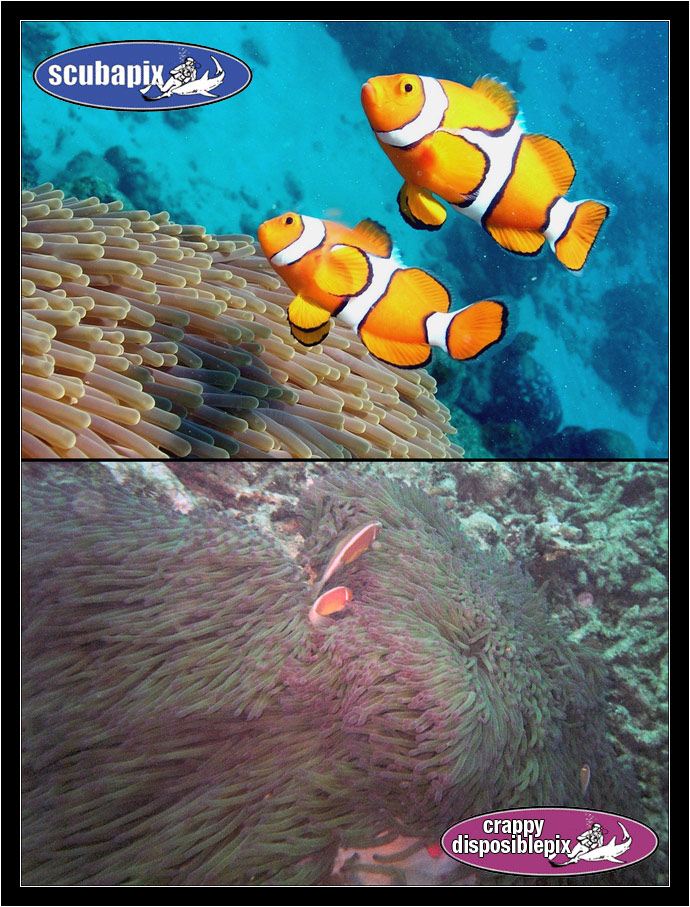
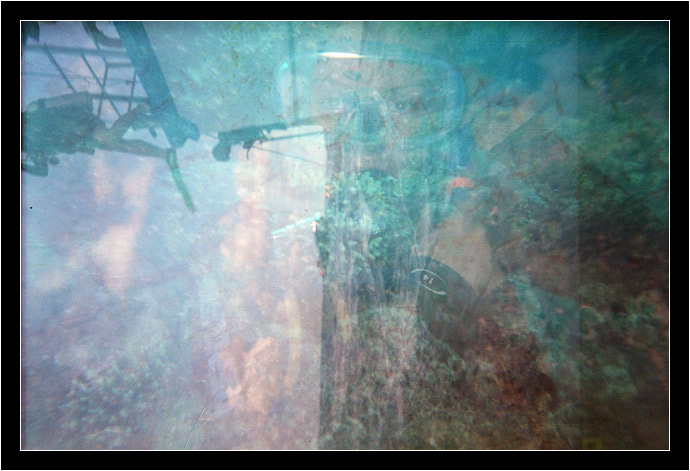

I like picture #3 of the clown with the clown fish
hey hello!!
my name is edwin ,im from mexico!!
and i admire you guys!! ,im 16 years old!!
and i love the sea!! and all that things!! =)
i might can meet u one day!!
hello guys..!!
i’m here again =) to say hi to everydody!!
well im very proud cuz maybe you’ll going to travel near to me!! =)
if you come ,please tellme!! …………please!!
it would be a plaeasure met you!!
Bueno pues cualquier cosa diganme!! estamos en contacto!! muchas gracias por responder!!